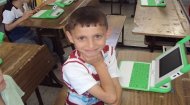| 
|
Children in Gaza | Children in Gaza | Children in Gaza | Children in Gaza |
|

There are some one million children living in the territory including 22,000 orphans. A study conducted in 2020, before the latest conflict, found that 53.5% of them were suffering from PTSD and nearly 90% had experienced personal trauma. This in a territory where the future is already bleak with 53.7% in the strip unemployed (one of the highest rates in the world) and youth unemployment even higher at 60%, leaving 80% of the Strip's population reliant on some form of humanitarian aid. This has inevitably impacted on life for children in Gaza with increasing school drop-out rates, children engaged in labour to survive, substance abuse and early marriage. As one aid worker stated, "Young children aren't spending enough time playing, which is central to healthy growth. They aren't building social emotional skills with their peers. Their lives are defined by fear, often concerning the safety and permanence of their caregivers."
The education system itself normally comprises compulsory basic education from Grade 1 to 10 (divided into the preparatory stage ~ Grades 1 to 4 ~ then the 'empowerment stage' ~ Grades 5 to 10). Secondary education (general secondary education and a few vocational secondary schools) then covers Grades 11 and 12. One girl, who normally arrives at school already hungry because her family can't afford breakfast, commented on the situation, "We have drinking water taps in school, but the water is contaminated so I avoid it. My class is overcrowded – there are 44 pupils crammed into one room. It is difficult to hear what the teacher is saying and it is hard to concentrate. My desk and chair are also old and broken." Further education opportunities are also limited as the young people are denied permission by Israel to leave Gaza to study in the West Bank or elsewhere even if they have already obtained a visa to travel internationally when there's no program in Gaza for their field of study. Despite this, many children in Gaza continue to demonstrate great skills and talents, a determination to learn and succeed despite the odds. Of course children in Gaza play like all others. Often its flying kites, mucking around on the beach and, of course, football but many of their games in the bombed out streets are war games with pretend guns and rocket launchers even pretend torture and interrogation. And that's what they have to play with because there's nothing else. As one ten year old stated, "All that's left is sand. If they could have destroyed the sand, they would have destroyed that too." You can help when you sponsor a child in Gaza or support one of the projects above. |








 During the attacks on Gaza, countless schools have been damaged, many entirely destroyed without any means to rebuild given ongoing restrictions by Israel regarding the importing building materials. As such, the high number of students and limited schools places taht remain, means most schools now run a two shift system - morning and afternoon - to accommodate the students.
During the attacks on Gaza, countless schools have been damaged, many entirely destroyed without any means to rebuild given ongoing restrictions by Israel regarding the importing building materials. As such, the high number of students and limited schools places taht remain, means most schools now run a two shift system - morning and afternoon - to accommodate the students.


